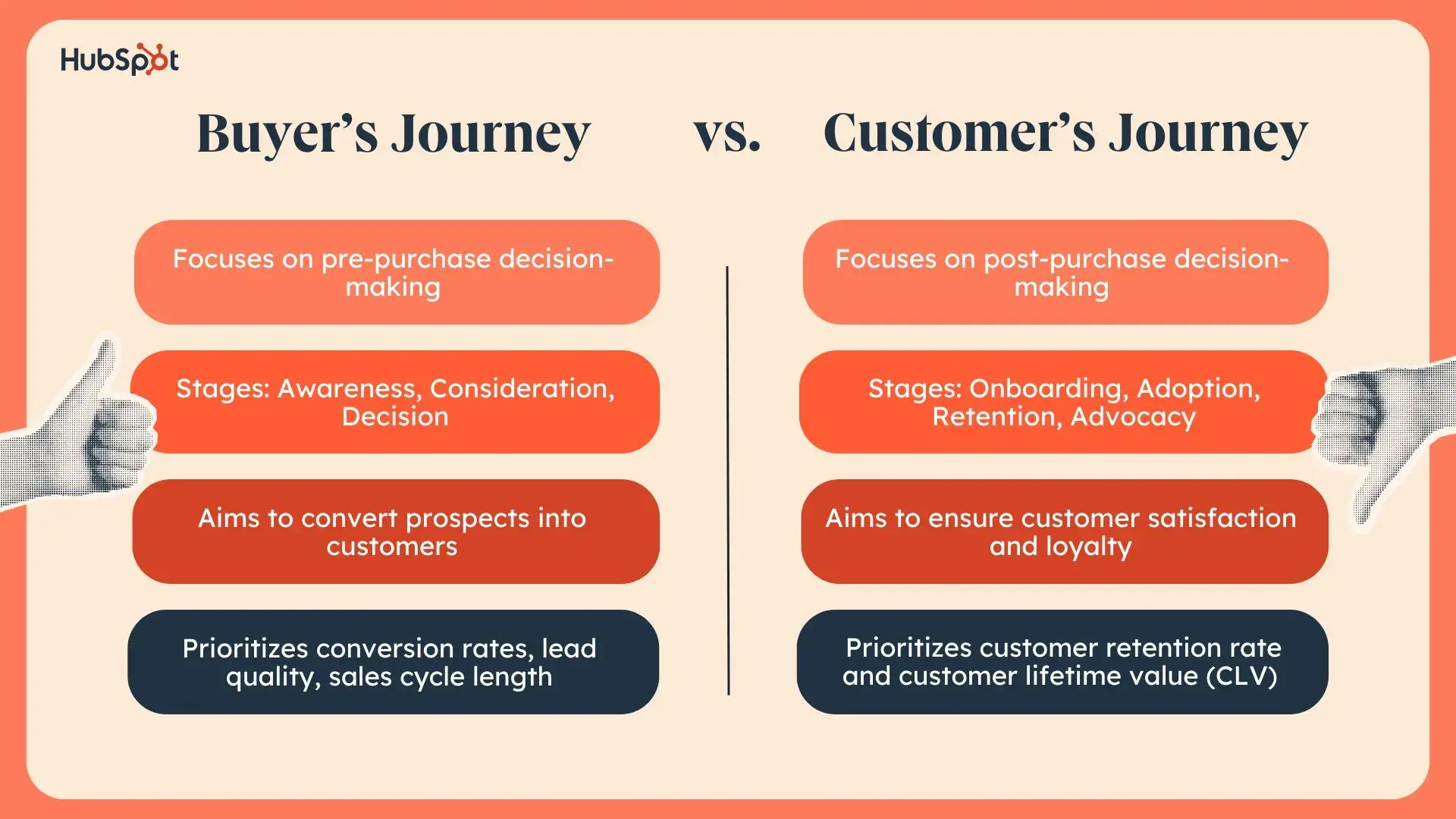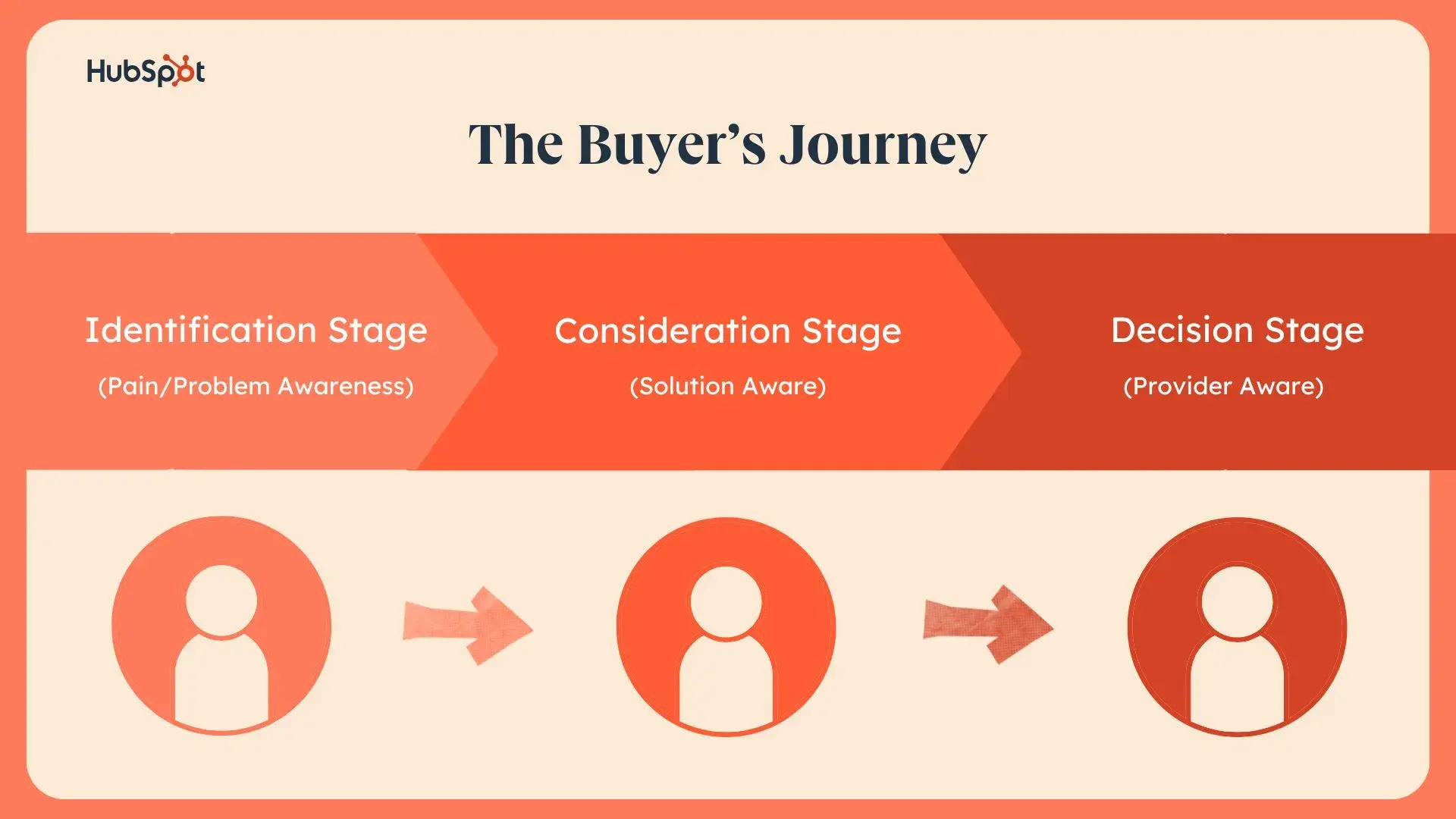Instead, to be successful in sales today, sales reps must adapt their mindset from selling to helping. The best way to start this process is to become intimately familiar with the buyer and the journey they take on their path to purchase: the buyer’s journey.
In this post, I’ll cover everything you need to know about the buyer’s journey, what it looks like in B2B versus B2C spaces, and how to apply it to your sales cycle.
Let's get into it.
Table of Contents:
- What is the buyer's journey?
- Difference Between the B2B Buyer’s Journey and the B2C Buyer’s Journey
- Buyer’s Journey vs. Customer’s Journey
- What are the three stages of the buyer’s journey?
- Tips for Applying the Buyer’s Journey to the Sales Cycle
- Final Thoughts: Making the Buyer’s Journey Work for You
By understanding the buyer’s journey, the pains and problems they experience as they navigate a potential purchase, along with the influencing factors that shape their thinking, salesfolks can better empathize with the buyer and position their product or service along that path.
However, not all buyer’s journeys look the same. Each process varies significantly depending on whether the buyer is an individual consumer or a business decision-maker. B2B and B2C buyers have different motivations, timelines, and decision-making processes, which impact how sales teams should approach them.
In the next section, I’ll break down the key differences between the two journeys so you can modify your sales strategy accordingly.
Difference Between the B2B Buyer’s Journey and the B2C Buyer’s Journey
The B2B buyer’s journey and the B2C buyer’s journey may sound the same, but, in practice, they’re entirely different. Like I previously shared, the decision-making process, sales cycle, and customer motivations vary, ultimately shaping how businesses approach their sales and marketing strategies. If you want to understand the ins and outs of either, it starts with distinguishing the two.
Check out the list I put together of how each process compares (with examples of what their respective buyer’s journey might look like) below:

1. Length of the Decision-Making Process.
Typically, the B2B buyer’s journey is longer and more complex than the B2C buyer’s journey. The B2B buyer’s journey involves multiple stakeholders, from C-suite executives to finance departments, so getting folks fully aligned on decisions takes some time.
Oppositely, the B2C buyer’s journey is quicker, primarily because it’s a process sustained on emotion. Customers make purchase decisions based on personal needs, desires, or impulses. While some B2C products (i.e., cars or real estate) require research and additional time, most B2C decisions involve fewer people and less deliberation.
2. The Sales Cycle Length.
As I previously mentioned, the B2B buyer’s journey involves multiple people from start to finish. Thus, it takes longer; sometimes, the B2B buyer’s journey can take weeks, months, or even years. It involves multiple touchpoints, such as:
- Lead nurturing
- Consultations
- Product demonstrations
- Proposals
- Contract negotiations
Because the B2C buyer’s journey operates more quickly, its sales cycle is shorter. It ranges from instant (i.e., e-commerce purchases) to a few days or weeks (i.e., renting an apartment). The journey moves quickly from awareness to purchase, often influenced by mass marketing, accessible customer reviews, or word-of-mouth (WOM) recommendations.
3. The Marketing and Sales Approach.
If you’re ever struggling to fully remember how the B2B buyer’s journey and B2C buyer’s journey compare, take a moment to reflect on the differences between the two through their designated approaches to marketing and sales efforts.
In the B2B buyer’s journey, marketing and sales efforts often hyperfixate on relationship-building, education, and value-driven content (i.e., case studies, webinars, email nurturing, etc.). However, in the B2C buyer’s journey, there’s a reliance on brand awareness through ads, social media, influencer marketing, and promotional strategy.
For example, a B2B tech company might generate leads through LinkedIn outreach; a B2C fashion brand may focus on Instagram influencers and flash sales to drive conversions.
4. Pricing and Negotiation.
In the B2B buyer’s journey, prices are usually customized and involve lots of negotiation, not just over price but over contracts and other long-term agreements (i.e., volume discounts, service-level agreement, recurring subscriptions, etc.).
Conversely, the B2C buyer’s journey takes a more rigid, non-negotiable approach to pricing and negotiation. Usually, prices are fixed (with the exception of discounts, sales, or loyalty programs) and clearly communicated upfront to consumers.
For example, a B2B SaaS provider may offer custom pricing based on a company’s size and needs, while a B2C subscription service (i.e., Hulu or Netflix) has set monthly pricing.
Buyer’s Journey vs. Customer’s Journey
Now that I’ve covered the key comparisons between the B2B buyer’s journey and the B2C buyer’s journey, I think it’s only fitting that I transition to talking through some of the distinctions between the buyer’s journey and the customer’s journey.
Take a glance at the list I assembled below for some further clarity on both journeys, their unique stages, and how each individual journey impacts the overall customer experience:

1. Definition and Focus.
Let’s start with the basics, shall we? If you want to know why the buyer’s journey and the customer’s journey are disparate, this understanding begins with having clarity on how each journey is actually defined.
The buyer’s journey is the process in which a potential customer goes through before making a purchase decision. It focuses on awareness, consideration, and decision-making prior to becoming a paying customer.
The customer’s journey, however, represents the entire experience a customer has with a brand after making a purchase, including onboarding, support, retention, and advocacy. The customer’s journey focuses on building loyalty, satisfaction, and long-term relationships; it’s about turning buyers into repeat customers and, hopefully, brand evangelists.
2. Different Stages.
I briefly mentioned the stages of the buyer’s journey and the customer’s journey above. Here’s what each stage really means in a bit more detail:
The Buyer’s Journey Stages (Pre-Purchase)
- Awareness: The buyer realizes they have a problem or need
- Consideration: The buyer researches possible solutions
- Decision: The buyer evaluates options and makes a purchase
The Customer’s Journey Stages (Post-Purchase)
- Onboarding: The customer gets started with a product or service
- Adoption: The customer actively uses the product or service
- Retention: The company engages with the customer to prevent churn (i.e., sending post-purchase emails and details, etc.)
- Advocacy: The customer is satisfied and refers others
3. Different Primary Goals.
As the buyer’s journey and the customer’s journey are separate processes, they have different goals.
The buyer’s journey prioritizes converting potential customers into paying ones. At this stage, businesses focus on educating prospects, addressing pain points, and positioning their product or service as the best solution. Strategies like content marketing, personalized outreach, and product demonstrations play a huge role in moving buyers toward a purchase.
The customer’s journey, on the other hand, is all about maintaining and strengthening the relationship after the purchase. It aims to always keep customers happy, engaged, and loyal to a brand. This phase often includes customer service interactions, loyalty programs, upsell opportunities, and encouraging brand advocacy through referrals and reviews.
When in doubt about specifying how these two journeys apart from one another, just remember: While the buyer’s journey ends at conversion, the customer’s journey is an ongoing process.
4. Different Metrics of Success.
The buyer’s journey centers the following metrics:
These metrics help businesses evaluate how effectively they attract, nurture, and convert potential customers into paying ones.
The customer’s journey relies these metrics:
These indicators help businesses assess the efficiency of their sales funnel and identify areas for improvement in the acquisition process.
What are the three stages of the buyer’s journey?
If you want to understand the buyer’s journey in its simplest form, I suggest thinking about the three stages that make the buyer’s journey flow seamlessly.
To help you grasp them more clearly, review my step-by-step breakdown of the buyer’s journey below:

1. Awareness Stage: The buyer becomes aware that they have a problem.
During this stage, the buyer is experiencing a problem or symptoms of pain, and their goal is to alleviate it. They may be looking for informational resources to more clearly understand, frame, and give a name to their problem.
2. Consideration Stage: The buyer defines their problem and considers options to solve it.
Next, the buyer will have clearly defined and given a name to their problem, and they are committed to researching and understanding all available approaches and/or methods to solving the defined problem or opportunity.
3. Decision Stage: The buyer evaluates and decides on the right provider to administer the solution.
Finally, the buyer has decided on their solution strategy, method, or approach. Their goal now is to compile a list of available vendors, make a short list, and ultimately make a final purchase decision.
If you don’t have an intimate understanding of your buyers, it may be difficult to map out the buyer’s journey in a way that will be helpful from a sales perspective. In this case, be sure to conduct a few interviews with customers, prospects, and other salespeople at your company to get a sense of the buying journey.
Tips for Applying the Buyer’s Journey to the Sales Cycle
Simply put, buyers don’t want to be prospected, demoed, or closed when they’re not ready. When offered at the wrong time, these steps add zero value from their perspective. However, a sales rep can shine when buyers seek additional information about your product that can't be found online.
When it comes to mastering the buyer’s journey, timing is truly everything, so here are my suggestions for how to engage buyers at the right moment:
1. Awareness Stage
When buyers are in the awareness stage, they recognize a challenge or opportunity that needs attention. They also decide whether the challenge or opportunity should be a priority.
Because of this, sales folks must approach potential buyers with sensitivity, not sales pitches. As I mentioned above, instead of pushing a product or service, the goal should be to help buyers articulate their problem, explore potential impacts, and guide them toward the next steps in their journey.
In short, at this stage of the buyer’s journey, don’t expect customers to choose your brand because its the first option they come across. Buyers will take their time to think on what to do next; all you can do is provide resources that give them more insight about your offering.
Take a look at this chart I assembled to help you think through how you want to go about capturing buyers’ attention effectively during this stage:
|
What You Should Be Asking |
Actions You Should Be Taking |
|
How do buyers describe their goals or challenges in the context of our business? How are our buyers educating themselves on these goals or challenges? What are the consequences of buyer inaction? Are there common misconceptions buyers have about addressing the goal or challenge? How do buyers decide whether the goal or challenge should be prioritized? |
Creating informational, not sales, sales collateral that educates them along their path to purchase. Providing them with resources to help them define the problem. Helping, helping, helping. |
Here are a few other tips to consider:
- Offer different types of engagement to customers based on readiness. Think low-commitment webinars for early-stage buyers, free product trials for those closer to a decision, and personalized consultations for customers who need some extra reassurance before making a purchase.
- Use lead storing whenever you can. Lead scoring will help you identify when a customer is actively researching vs. just starting their buyer’s journey.
2. Consideration Stage
By this point, buyers have clearly defined the goal or challenge and have committed to addressing it. They are now evaluating different approaches or methods to pursue the goal or solve their challenge.
This is a high-stakes, particularly fragile part of the buyer’s journey. Why? Because buyers are actively comparing solutions, possibly making a pros/cons list to help them choose what’s the best fit for them, and, all-in-all, seeking any final signs of validation for the decision they’ll make. Most likely, buyers are using these moments to:
- Scour social media for demos
- Look for testimonials/reviews from real customers
- Analyze case studies to see how others have successfully used the product or service
At this stage, salesfolks must position themselves as trusted advisors, not just sellers. Instead of pushing a one-size-fits-all solution, sales teams should provide as many value-driven resources as possible that help buyers confidently choose an approach — whether that includes their product or not.
Here’s another chart I organized to guide you through how to navigate this stage:
|
What You Should Be Asking |
Actions You Should Be Taking |
|
What categories of solutions do buyers investigate? How do buyers educate themselves on the various categories? How do buyers perceive the pros and cons of each category? How do buyers decide which category is right for them? |
Understanding exactly how our product or service solves their problem compared to our direct and indirect competitors. Considering how our direct and indirect competitors show up in the marketplace and how they influence perception. Providing the buyer with resources to help them determine the right solution for them. |
3. Decision Stage
Finally, when buyers make it to this part of their journey, they’ve decided on a solution category and are now evaluating providers.
This is a crucial part of the buyer’s journey because they’re on the verge of making a final commitment. Buyers are comparing features, pricing, implementation processes, and overall satisfaction with the product or service they’re considering. Trust and credibility play a huge role here; buyers want reassurance that they’re making the right choice.
So, what should salesfolks do when they’ve arrived to this stage of the buyer’s journey? Well, in my opinion, it’s all about eliminating friction and reinforcing confidence by addressing lingering doubts and offering tailored recommendations.
To figure out what to ask and what to do as a salesperson seeking alignment with this stage, review my list of recommendations below:
|
What You Should Be Asking |
Actions You Should Be Taking |
|
What criteria do buyers use to evaluate the available offerings? When buyers investigate our company's offering, what do they like about it compared to alternatives? What concerns do they have with it? Who needs to be involved in the decision? How does each person involved's perspective on the decision differ? Do buyers have expectations around trying the offering before they purchase it? Do buyers need to make additional preparations outside of purchasing, such as implementation plans or training strategies? |
Understanding what objections they might have before the sales process so that you can adequately handle them. Ensuring you have a unique selling proposition that provides value to the buyer and sets you apart from competitors. |
Some of these considerations may fall more under the marketing umbrella than the sales umbrella. Still, ultimately, the answers to these questions will provide a robust foundation for your buyer’s journey.
Final Thoughts: Making the Buyer’s Journey Work for You
Knowing how your buyers buy is invaluable as you create or refine your sales process. Once you’ve unlocked the hows and the whys behind their decision-making processes, you’ll better empathize with them, handle their objections, and provide them with correct information at the right time, helping you close more deals and win more business.
If you walk away from this post having learned anything, I hope it’s these three things:
- Take the time to understand your buyers
- Refine your strategy
- Meet buyers where they are (with the right information, at the right time)
Once you put these things into practice, watch your sales process become smoother, smarter, and more successful. Because when you sell the way buyers want to buy, everybody wins.

.png)
.webp)

![B2B Sales Experience: 12 Best Ways to Delight Prospects [Examples]](https://53.fs1.hubspotusercontent-na1.net/hubfs/53/b2b-sales-experience-1-20250516-6151471.webp)



